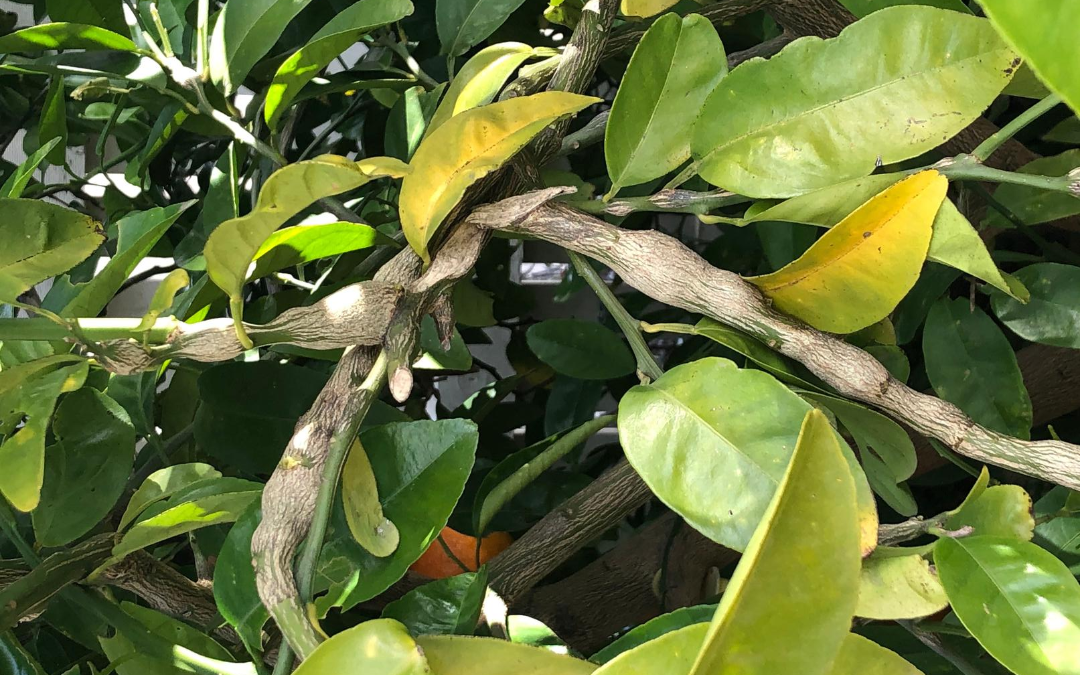Defeat citrus gall wasp (and Queensland Fruit Fly) with kaolin clay!

Citrus gall wasp, an Aussie wasp originally from Queensland, can affect all citrus but seems most prevalent in lemon, lime, cumquat and grapefruit trees. The galls result from the injection of eggs by the adult wasp into the soft stems of citrus trees in spring. Here the larvae hatch within a month and develop within the tissue for the next year. Eventually, the larvae pupate and the result is the emergence of the adult wasp in late November and early December, and the cycle begins again.
Galls are generally seen as ugly gray growths on the stem with tiny holes on the surface. These however are ‘dead’ galls. They have served their purpose and the inhabitants have fled to infect new trees. The ones we need to worry about are small swellings or bumps that are green in colour and on soft stems. These can rarely be seen when they are less than 3mm in size so keep checking your tree, but take precautions early in October.
Galls often appear in spring/summer toward the end of new growth where the fruit is, and this makes it problematic. If this growth is pruned out then there is a loss of fruit. An alternative is to use a sharp knife or vegetable peeler and slice away the bump, making sure that you can see the pinpricks that indicate the presence of the larvae. If you cannot see these pinpricks, then slice away some more until they become visible. It is exposing them that allows the wind to dry the gall out and kill the developing wasp. Dispose of the galls by burning, or soaking in a bucket of water for a month. Do not put them in the compost or the green bin.
Prevention, of course, is better than cure. There are no known predators of the gall wasp so physical solutions must be applied, but none are failsafe. Vigilance is a key ingredient of successful eradication. Remember that fruit trees adjacent to your property that are not managed will be the source of further infestations.
A three-pronged strategy works well.
Firstly, the more soft young growth on the tree, the more likely it will be attacked so avoid using high nitrogen fertiliser in spring (see below for a list of high nitrogen fertilisers).
Secondly, use gall wasp pheromone traps. These are yellow cylinders that should be hung from citrus trees between August and November. Remove them in late December so they do not trap beneficial insects. These traps have a sticky surface that captures the tiny wasp but also emits a powerful pheromone that attracts them to the cylinder. To release the pheromone you must turn the top of the cylinder otherwise, it will be next to useless. Gall wasp traps are about $10 each and for a small tree you need one, for a medium tree two and for a large tree four. This can be quite an expense if you have a number of trees. Roughly $240 a year for me.
One year having had some gall wasp the previous year, I decided to ‘save’ by not buying pheromone traps. The result was disastrous. My lemon tree was covered in gall by summer so while they may not be 100 per cent effective, they are important in reducing damage. Despite the recommendation that trees are not pruned more than a third in a season, we lopped back that lemon tree in winter, to knee height, and it has flourished, gall-free.
Thirdly, and this is an exciting development, a spray-on clay has come onto the market that is giving excellent results. It’s called calcined Kaolin Clay (sold as Overhaul by our local nurseries) and is applied in spring and disrupts the gall wasp cycle, and that of Queensland Fruit Fly. It looks rather messy (a bit like it has snowed) but that is a small price to pay for a short period to be free of gall (or almost free!). An experiment run by ‘Leaf, Root and Fruit’ (based in Burwood Victoria) over 3 years is well worth the read.
‘Leaf, Root and Fruit’ began with 10 small lemon trees and treated them with varying regimes. Kaolin Clay was the most effective in reducing galls. The trees are now sprayed 4 times at fortnightly intervals beginning in the third week of October and ending at the end of the first week of December. Interestingly, they found that the ‘Prune in June’ strategy was not effective and that the Kaolin regime (which included fertilising monthly from September – May only), produced the least galls and the most fruit – both in number and weight.
At the Sustainable Macleod Community Garden, we successfully used this regime. However nowadays with Queensland Fruit Fly to contend with, we net all our trees, weighing the netting hem down with heavy objects or burying it, to keep Queensland Fruit Fly at bay, and this also deals with gall wasp. This means that we no longer need to continue the regime per se. However, if we have developing fruit and flowers on a citrus tree at the same time, which happens regularly due to climate change, kaolin clay is useful. It is also an excellent option for large trees that are difficult to net.
Written by Robin Gale-Baker
